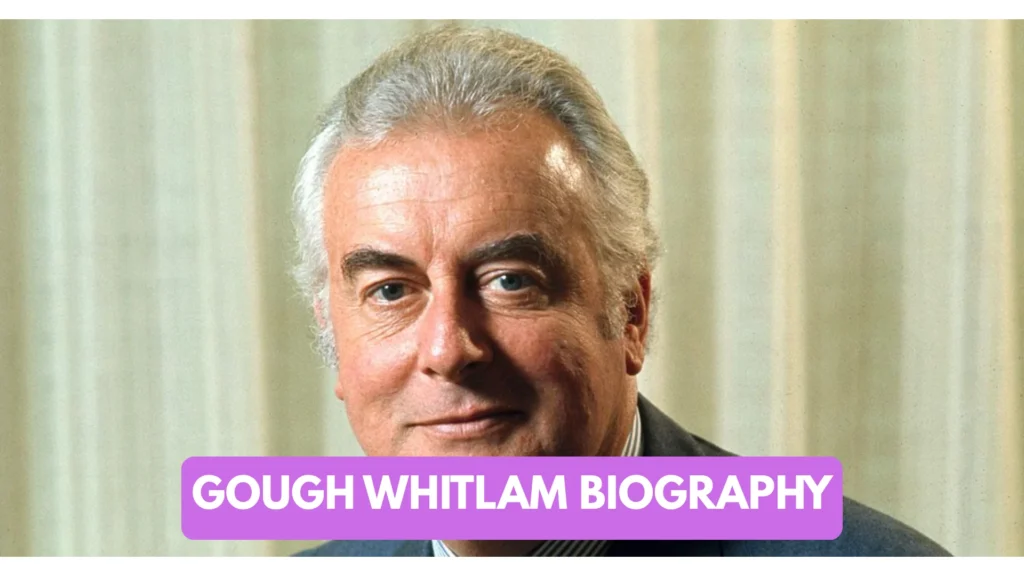
Gough Whitlam (1916-2014) remains one of Australia’s most consequential and controversial political figures. From his early years in Melbourne and Canberra to his wartime service, legal career, long parliamentary journey and dramatic premiership culminating in dismissal, Whitlam’s story is one of bold reform, ambition, and constitutional upheaval. In this biography we explore his early life, political ascent, achievements in office, the crisis of his dismissal and the legacy he left behind.
Facts
- Full Name: Edward Gough Whitlam
- Born: July 11, 1916
- Death: October 21, 2014
- Birthplace: Kew, Melbourne, Victoria, Australia
- Nationality: Australian
- Occupation: Politician, Lawyer, Former Prime Minister of Australia
- Religion: Agnostic (raised Christian)
- Parents: Fred Whitlam (Henry Frederick Ernest Whitlam) and Martha Whitlam (née Maddocks)
- Spouse: Margaret Elaine Whitlam (née Dovey)
- Children: Antony Whitlam, Nicholas Whitlam, Stephen Whitlam, Catherine Dovey
- Relationship: Married (until Margaret Whitlam’s death in 2012)
Early Life and Education
Gough Whitlam was born on 11 July 1916 in the suburb of Kew, Melbourne, Victoria. He was the elder of two children of Fred (Henry Frederick Ernest) Whitlam, a public servant who later became Commonwealth Crown Solicitor, and Martha (née Maddocks). In 1926 the family relocated to Canberra when Fred Whitlam’s service brought them there.
Whitlam attended Mowbray House and Knox Grammar School in Sydney, and in Canberra he studied at Telopea Park Intermediate High School and Canberra Grammar School. He enrolled at the University of Sydney in 1935, initially studying arts and then law.
Wartime Service and Early Career
During World War II, Whitlam enlisted in the Royal Australian Air Force (RAAF) on 20 June 1942, training as a navigator and bomb aimer, serving with No. 13 Squadron in the Northern Territory and later with the Pacific echelon of General MacArthur’s headquarters in the Philippines. He married Margaret Elaine Dovey in Sydney on 22 April 1942.
After the war he resumed his law studies, gained his LL.B., and was admitted to the New South Wales bar in 1947.
Entry into Politics
Whitlam joined the Australian Labor Party (ALP) in 1945. He entered federal Parliament when he won the seat of Werriwa (in Sydney) at a by-election in 1952. He became Deputy Leader of the ALP in 1960 and then Leader of the Opposition in 1967.
Prime Ministership: 1972-1975
On 5 December 1972 Whitlam became Australia’s 21st Prime Minister—bringing the ALP back to government after more than two decades in opposition. His government moved quickly with a sweeping reform agenda: ending military conscription, lowering the voting age from 21 to 18, establishing universal health care (Medibank), recognising the People’s Republic of China, abolishing university tuition fees (though later modified), and expanding Aboriginal affairs and the environment portfolio.
Reforms and Achievements
- The voting age lowered to 18 in 1973.
- Recognition of China (21 December 1972).
- Establishment of the Australian Legal Aid Office in 1973.
- Abolition of the death penalty in Australia via the Death Penalty Abolition Act 18 September 1973.
- Major expansions of social policy, including health, education and indigenous rights.
Challenges and the Dismissal
Despite the ambitious reforms, Whitlam’s government faced serious economic headwinds: rising inflation, unemployment, a global oil crisis and internal mis-steps. The ultimate crisis erupted when the Senate, controlled by the opposition, blocked supply — government spending bills — in 1975. Whitlam refused to call a half-Senate election, and on 11 November 1975 he was dismissed by the Governor-General Sir John Kerr, in one of the greatest constitutional shocks in Australian history.
After Politics and Legacy
After leaving office Whitlam remained a prominent voice in public life. He resigned from Parliament on 31 July 1978. He held several honorary and public roles — for example as Ambassador to UNESCO, Chair of the National Gallery of Australia, and was appointed Companion of the Order of Australia in 1978. Whitlam died on 21 October 2014 in Sydney at age 98.
His legacy lives on in the transformative reforms he initiated and his role in modernising the ALP and Australian politics. He remains both admired and critiqued — a reformer whose ambition far outstripped his time in office.
FAQs
Q1: When was Gough Whitlam Prime Minister of Australia?
A1: He served as Prime Minister from 5 December 1972 to 11 November 1975.
Q2: Why was Whitlam dismissed as Prime Minister?
A2: His government lost control of supply (budget bills) in the Senate, declined to call a half-Senate election, and the Governor-General dismissed him in a constitutional crisis.
Q3: What major reforms did Whitlam introduce?
A3: Among many reforms: ending conscription, lowering voting age to 18, establishing Medibank (universal health), recognising China, expanding Indigenous Affairs, instituting legal aid, abolishing death penalty.
Q4: What is Whitlam’s legacy today?
A4: He is remembered as a bold reformer who transformed Australia’s social policy landscape and changed the Labor Party’s direction. His dismissal also remains a pivotal moment in Australia’s constitutional history.
Q5: How old was Gough Whitlam when he died?
A5: He died at the age of 98 on 21 October 2014 in Sydney.
Conclusion
Gough Whitlam’s life is a story of vision, transformation and controversy. He emerged from wartime service and legal practice into a vigorous political career and achieved in three short years as Prime Minister what many examine in decades. His government redefined Australia’s social policy, its place in the world, and the ambitions of its citizens. Yet his abrupt dismissal also highlights the fragility of political power and the complexity of democratic governance. For anyone interested in the shaping of modern Australia, the Whitlam era offers inspiration and caution in equal measure.




